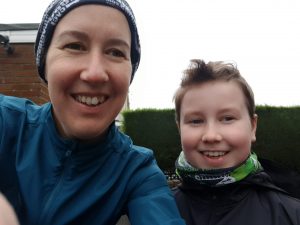Running for Jacob
I can’t do anything to change what Jacob has been through, and is going through, but through a challenge like this I feel I can bring something positive and give something back.
In June 2019, eight year old Jacob was diagnosed with a brain tumour. Suffering from headaches and vomiting, they discovered that Jacob had a Craniopharyngioma. Bravely, Jacob underwent surgery later that month, supported by his family – including parents, Heather and Mark, and siblings, Adam and Emma. Just a few months later, the family received a call to say that Jacob would be returning to hospital as the decision had been made to debulk his tumour.
Back at home
When Jacob and his family finally returned home following his treatment, Heather connected with brainstrust.
“brainstrust sent Jacob a brain box and a Build a Bear teddy. It gave us all a real lift in lockdown. The team also connected with me and were a lovely support, I know if I ever need them that they are there.
Today, Jacob is doing well. What remains of the tumour is stable, I’m glad to report that he is a happy boy. He lives with the effects of treatment – having lost his pituitary function, he requires hormone replacement daily (the pituitary does a lot)! We didn’t ever think we would be one of the 30 people a day who hear, or see in writing, your child has a brain tumour. But here we are, still standing, and smiling, and very thankful for all the support along the way.”
Giving something back
Just over a year after Jacob’s first surgery, Heather decided to take on our Run, Row, Ride challenge, conquering 30 miles throughout the month of November. Jacob, and his siblings, Adam and Emma, joined Heather for a mile of the challenge, and were her biggest cheerleaders along the way. The family raised an incredible £1,200 for brainstrust, and loved every aspect of taking part. Heather said:
 “I absolutely loved doing the challenge! To be honest it did me the world of good – some time out everyday, running with different friends who wanted to support me, better fitness – and all for a great cause. I can’t do anything to change what Jacob has been through, and is going through, but through a challenge like this I feel I can bring something positive and give something back.”
“I absolutely loved doing the challenge! To be honest it did me the world of good – some time out everyday, running with different friends who wanted to support me, better fitness – and all for a great cause. I can’t do anything to change what Jacob has been through, and is going through, but through a challenge like this I feel I can bring something positive and give something back.”
Team brainstrust
We’re so very grateful to Heather, Jacob and their family and friends. We were thrilled to hear how much of a difference the challenge made to their lives, as well as to lives of the people their fundraising supports.
If you would like to follow in their footsteps, we have some fantastic challenge events lined up for #teambrainstrust throughout 2021. Simply click here to find out more!











